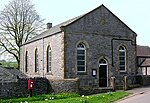Monyash
Derbyshire DalesTowns and villages of the Peak DistrictVillages in Derbyshire

Monyash (/muhn-ee-ash/ munyash) is a village and civil parish in the Peak District, Derbyshire, England, 5 miles (8.0 km) west of the market town Bakewell. It is centred on a village green 265 metres (869 ft) above sea level at the head of Lathkill Dale in the limestone area known as the White Peak. At the 2011 census, it had a population of 314. Tourism and farming (milk, beef and lamb) are the predominant activities of the village. The area was once an important meeting place, a watering point for drovers’ animals at the intersection of several trade routes, and industrial centre supporting the local lead mining industry.
Excerpt from the Wikipedia article Monyash (License: CC BY-SA 3.0, Authors, Images).Monyash
Church Street, Derbyshire Dales
Geographical coordinates (GPS) Address Nearby Places Show on map
Geographical coordinates (GPS)
| Latitude | Longitude |
|---|---|
| N 53.196 ° | E -1.777 ° |
Address
Church Street
Church Street
DE45 1JJ Derbyshire Dales
England, United Kingdom
Open on Google Maps










